Chapter 4 Why Do We Fall Ill
We all are aware of the fact that the cell is the basic structural and functional unit of life. Every cell is made up of various biomolecules like proteins, carbohydrates, lipids and nucleic acids. The cells are found in the dynamic state even in the condition when the cell is immobile, other functions like cell repair and the formation of new cells may take place continuously.
Any kind of improper functioning of these biomolecules will lead to health disorders and subsequently, multiple diseases. You must have heard about people talking about good and bad health.
Read and Learn More: NEET Foundation Notes
How can we define ‘health’ and ‘disease’? In the recent past, one of the most important things that man has realized is that numerous diseases can be prevented by taking simple preventive measures that include proper sewage system, safe drinking water, clean air and surrounding, and personal hygiene. The result of this activity reveals that health and diseases are interconnected, where ill health may lead to acquire several diseases.
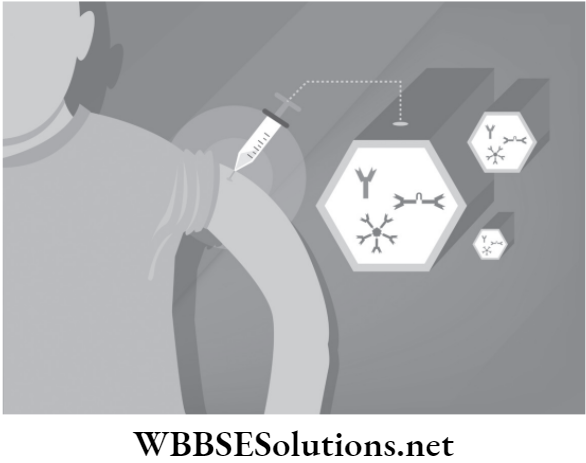
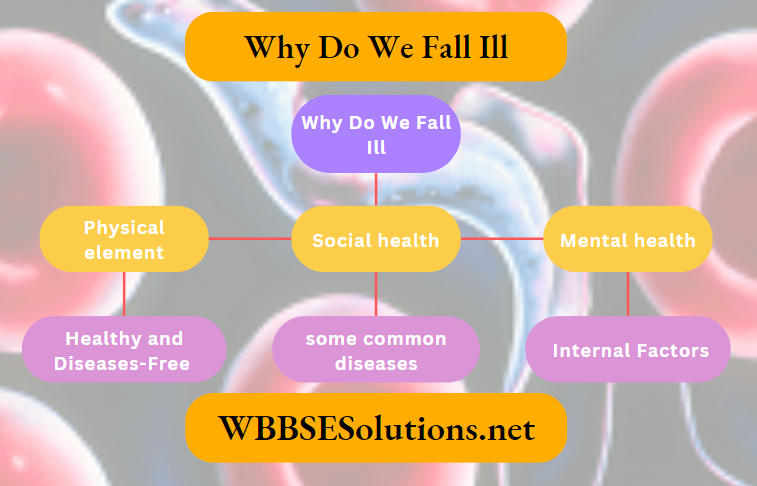
Chapter 4 Why Do We Fall Ill Health And Its Failure
The Significance of Health
Health depicts the notion of well-being. The meaning of good health may vary from person to person such as for a person working in coal mine, it refers to being fit to perform hard labour while at the same time a person working in office, it may refer to the mental fitness to take wise decisions.
Therefore, the term ’health’ can be defined as the state of complete physical, social and mental well-being. Being healthy does not merely stand for being free from disease. The World Health Organization defines health as a state of complete physical, mental and social wellbeing and not merely the absence of disease or infirmity.
However, maintaining good hygiene reduces the probability of accumulating disease. It reflects the ability of a person to feel good, have a positive outlook and to cope up with day-to-day activities without much difficulty.
The health of a person and community are interrelated. However, there are certain basic factors necessary to maintain the health of an individual such as personal hygiene, balanced diet, clean surroundings, proper exercise, good economic conditions, etc.
NEET Foundation Notes For Biology Chapter 4
The three fundamental elements of health are discussed below.
- Physical element: It deals with the body’s ability to partake in exercise, proper nutrition, enough sleep, weight management, abstinence from alcohol and drugs.
- Social health: It deals with the way we react with people in our environment and it includes public, peer and family relationship.
- Mental health: It deals with how we feel, think and manage with life.
Personal and Community Issues Both Matter for Health
The health of all organisms depends on its surroundings and the environment where they live. Besides that we live in villages, towns and cities, our socio-economic environment also plays a crucial role in determining our health.
Consider a situation where there is no agency to ensure proper collection and disposal of waste. What would happen if the drains are not cleaned regularly? Imagine yourself living in a place surrounded by a great deal of garbage thrown on streets with open drain and water being stagnant.
The possibility of developing poor health in such cases increases. Therefore, public cleanliness along with proper hygiene and sanitation is also an important factor to maintain an individual’s health.
Conditions Essential to Maintain Good Health
- Proper sanitation
- Availability of clean drinking water
- Availability of sufficient and nutritious food
- Social equality
Distinction between Healthy and Diseases-Free
Health is a dynamic state of well-being involving physical, mental and social domains which satisfies the demands of a life that is associated to age, culture, personal responsibilities. The term ‘disease-free’ describes a condition of well-being where one is not suffering from any disease, but cannot be considered as healthy.
Sometimes the body may function efficiently, but it is not compulsory that they are mentally and socially stable and active. Thus, ‘Not being diseased’ is not the same as being ‘healthy’ and we can be in poor health without a simple cause in the form of identifiable disease.
Difference between healthy and disease-free person

Chapter 4 Why Do We Fall Ill Disease And Its Causes
Each organ system in our body has a specific role to perform. The malfunctioning of any of these organs and organ system is characterized by various signs and symptoms, where it indicates the presence of a disease.
Disease
Disease is defined as an abnormal condition that disturbs or modifies the performance of the vital bodily functions. The disease may result as a response to either of the following factors as discussed in Table 4.2.
- Environmental factors: Industrial hazards, natural calamities and malnutrition.
- Infective agents: Worms, protozoan, bacteria, fungi and virus.
- Inherent defect of the organism: Genetic anomalies.
- Combination of the factors mentioned above.
Classification of some common diseases in humans
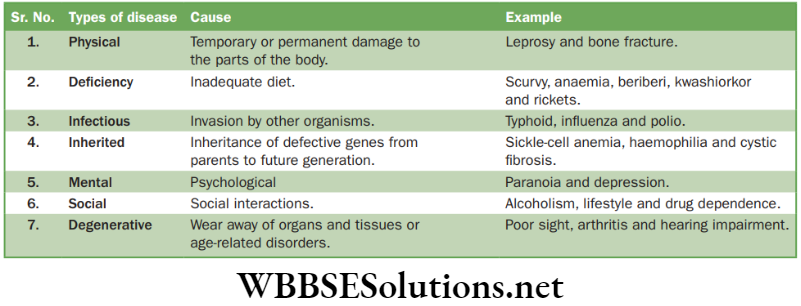
These changes leads to various symptoms and signs of disease. Symptoms are the indication of the existence of something especially of an undesirable situation where we feel that something is going wrong in our body. Headache, cough, dysentery, vomiting are all symptoms of ill health.
These symptoms indicate the persistence of a disease, but they do not indicate what kind of disease it is. For example, a headache may occur due to examination stress or meningitis, or migraine, etc., or any one of the several different reasons.
| Class 11 Physics | Class 12 Maths | Class 11 Chemistry |
| NEET Foundation | Class 12 Physics | NEET Physics |
The signs and symptoms of a disease are used interchangeably in common practice. However, there is a fine difference between the two terms. When we develop cough or headache or diarrhoea or a wound with pus at some point of time in life. These are all symptoms indicating discomfort but it does not indicate a specific disease.
For example, the symptoms of Chikungunya include high fever, headache, pain behind the eyes, severe joint and muscle pain, nausea, vomiting and skin rashes which can be mistaken for flu or any other viral infections. On the basis of these symptoms, a physician may diagnose Chikungunya infection with a blood test to check for the virus causing the presence of a particular disease.
Sources of Disease
There are various factors which directly or indirectly impair human health. There are two different types of sources, such as intrinsic or internal factors and extrinsic or external factors.
Intrinsic or Internal Factors
The disease causing factors which are found inside our body are termed as intrinsic factors. The vital intrinsic factors responsible for humans to feel ill are as follows.
- Genetic disorders
- Impairment of immune system.
- Improper functioning of body organs, such as heart, liver, kidney, etc.
- Hormonal imbalances are discussed in Table 4.3 (hypo or hypersecretion causes various diseases, like dwarfism, gigantism and diabetes).
Common diseases due to hypersecretion or hyposecretion of hormones
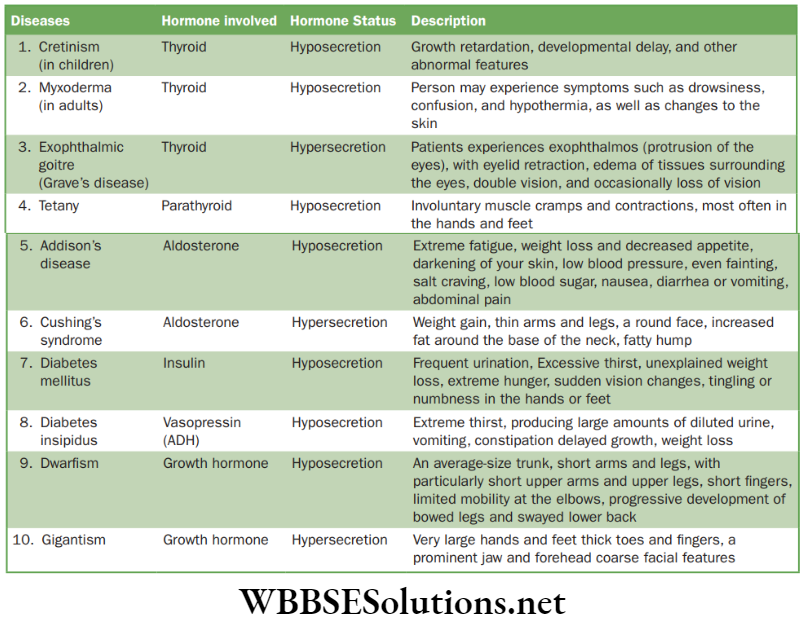
Extrinsic or External Factors
These are the diseases causing external agents which enter our body from outside. The various external factors involved are as follows.
- Insufficient diet or unbalanced diet makes a person unhealthy and prone to nutritional deficiency and acquire other diseases.
- Various pathogenic agents, like bacteria, fungi, virus and worms, etc., are external agents.
- Environmental pollutants like oxides of carbon, sulphur and nitrogen, heavy metals like mercury, lead and arsenic, pesticides may also affect our health.
- Tobacco, alcohol and narcotic drugs may also contribute to body ailments.
Some common deficiency diseases in human beings
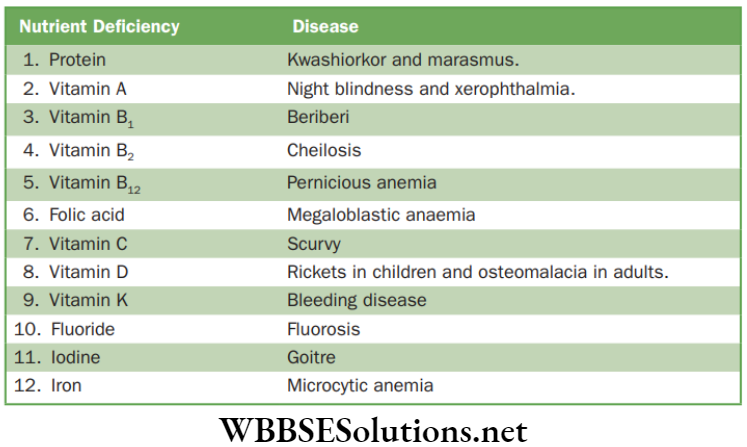
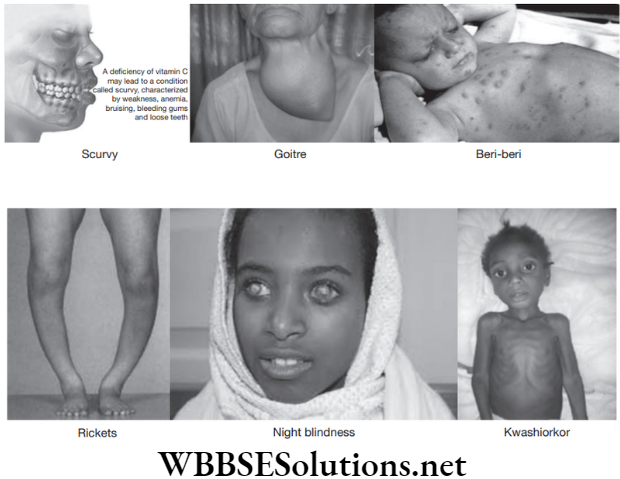
Chapter 4 Why Do We Fall Ill Types Of Diseases
Acute and Chronic Disease
Based on the duration for which a disease persists, it can classify human diseases into either acute or chronic. Any disease that causes malfunctioning of some parts of the body will impact our general health. Common cold and cough is commonly observed by us from time to time.
Most of us recover and get better very soon and there are no bad effects on general health. In case of acute diseases, we do not lose weight or become short of breath or tired. On the other hand, when we get infected with a chronic disease, such as tuberculosis of lungs and AIDS, it results in the loss of weight and tiredness of the individual.
- Acute disease: Disease such as common cold whose symptoms are rapidly visible is termed as acute disease.
- Chronic disease: Disease such as tuberculosis that are long-term and whose symptoms last for months or years are termed as chronic disease.
Difference between acute and chronic diseases

Congenital and Acquired Disease
Based on the occurrence of disease in the body since birth or after birth, the type of disease may be broadly classified as follows.
- Congenital disease: The disease which is present since birth as a result of genetic abnormalities or metabolic disorders is known as congenital disease.
- Acquired disease: The disease that develops after birth is known as acquired disease. They are further divided into two categories, such as (a) infectious or communicable disease; (b) non-infectious or noncommunicable disease.
Infectious diseases are caused by pathogens, such as viruses, bacteria, fungi and protozoans. Non-infectious diseases are caused due to inadequate diet, such as scurvy, kwashiorkor, etc.
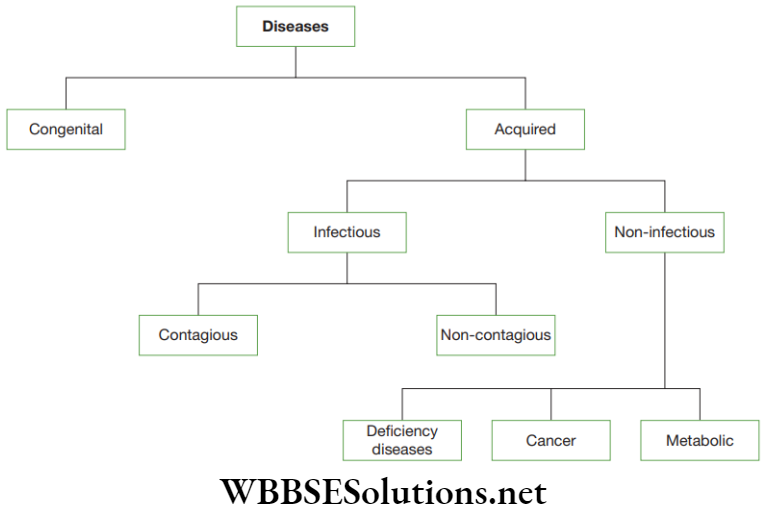
Characteristics difference between congenital and acquired diseases

Chapter 4 Why Do We Fall Ill Infectious Diseases
Infectious Agents
Infectious diseases are caused by pathogenic microorganisms, such as bacteria, viruses, parasites or fungi. The diseases can be spread, directly or indirectly from one person to another in a community.
The living world has enormous biodiversity classified into different groups and this classification is based on common characteristics among different organisms. Organisms that can cause diseases are found in a wide range of categories and it can be classified. Some of them are viruses, bacteria, fungi, protozoan’s (unicellular organisms) and worms (multicellular organisms).
Some of the common examples of diseases caused by viruses are common cold, influenza andAIDS. Diseases like typhoid, fever, cholera, tuberculosis and anthrax are caused by bacteria. Various common skin infections are caused by different kinds of fungi. Protozoan microbes cause diseases, such as malaria and kalaazar, sleeping sickness while elephantiasis is a worm infection.
- Viruses: Common cold, influenza, dengue fever, AIDS, chicken pox, measles and mumps.
- Fungi: Many common skin infections such as ringworm and athlete’s foot.
- Protozoans: Malaria, kala-azar, sleeping sickness.
- Bacteria: Typhoid fever, cholera and tuberculosis.
- Worms: Intestinal infections such as ascariasis, a parasitic infection by roundworm and elephantiasis, a parasitic infection caused by roundworm.
Why it is important to consider different kinds of infectious agents?
It is important to consider different kinds of infectious agents because
The answerlies within the mode of treatment to be chosen forthe disease.All these infectious agents have many biological characteristics in common. All viruses live inside the host cells where they multiply and increase their progeny, whereas bacteria very rarely follow the same procedure. Viruses, bacteria and fungi have high multiplication capacity whereas worms as compared to the pathogens multiply very slowly.
Here, the term common traits refer to the similarity observed in the biochemical processes in the cell. As a result, the drugs that block one of these biochemical pathways in one member of the group is likely to be effective against many other members of the same group. But the same drug will remain ineffective against a pathogen belonging to a different group.
For instance, let us talk about the antibiotic penicillin, it blocks the synthesis of the cell wall in bacteria. Many bacteria makes a cell wall to protect themselves against the immunological response of the host. As a result, the growing bacteria lose its capacity to synthesize cell walls, and die easily. Human cells cannot synthesize cell wall at any point of time in their life.
Therefore, penicillin remains passive on us. On the other hand, viruses do not use these biochemical pathways and therefore, remains passive on humans. If we have viral infection (cold), then taking antibiotics does not mitigate the severity or the tenure of the disease. Instead, our body produces an antiviral protein called interferon to combat with viral infection, whereas if we get a bacterial infection along with viral cold, then taking antibiotics will complement its efficacy.
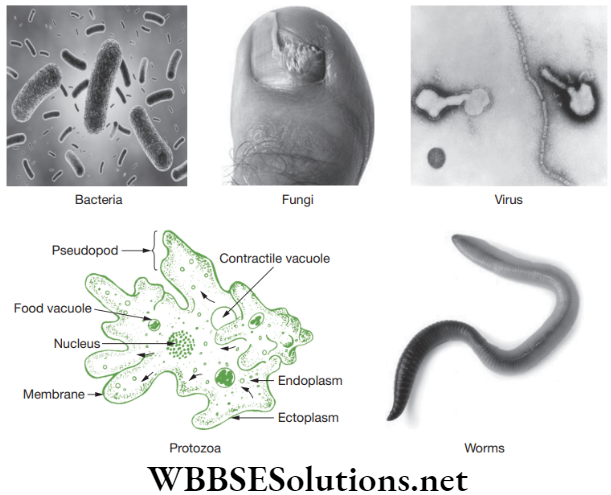
Common infectious diseases caused by various pathogens in humans
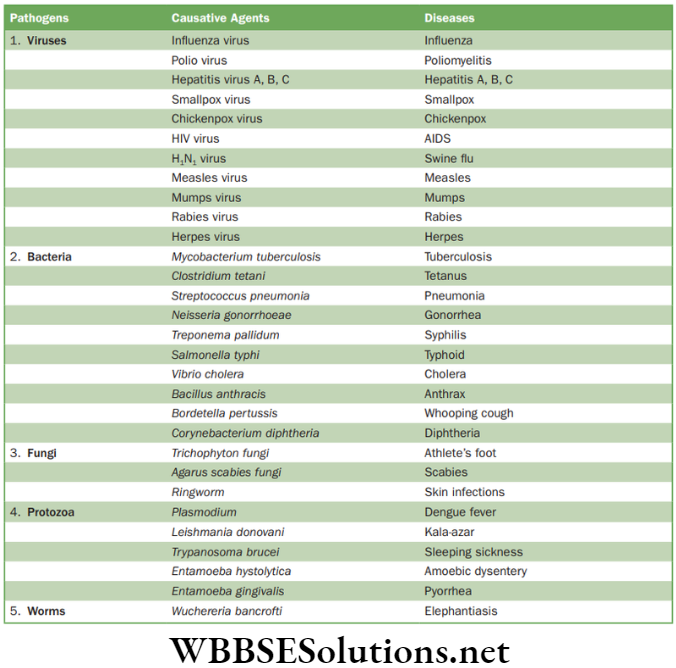
Means of Spread
How do infectious diseases spread? Most of the microbes are transmitted from an affected person to an immunized person in a variety of ways. They can be ‘communicated’ from one person to the other and so are also called communicable diseases. There are various modes of spreading the infection from an infected person to a healthy person through various modes which are broadly classified into two types and they are as follows.
- Indirect transmission: It occurs when there is no direct human to human contact. The spreading of diseases is through air, water, vectors and contaminated surfaces and objects.
- Direct transmission: It occurs when there is a physical contact between the infected and susceptible person. It includes sexual contact, animal bites and contact with soil. Let us discuss each of them in detail.
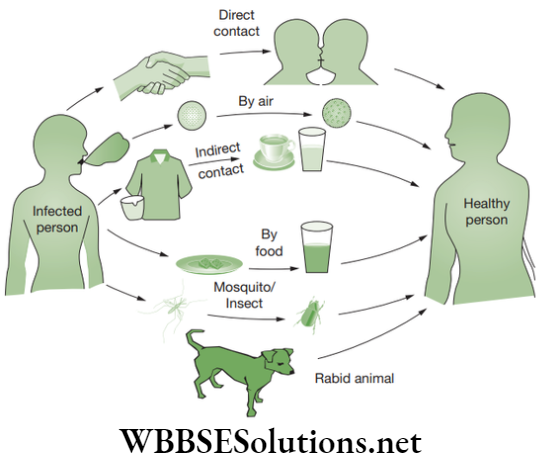
Indirect Transmission
- Airborne disease: Influenza, pneumonia and tuberculosis are the prominent examples of airborne diseases. The transmission occurs through little droplets thrown out by an infected person who sneezes or coughs towards someone standing in the vicinity of the infected person who inhales the droplets providing microbes a chance to infect the new host.
- Waterborne disease: Diseases can also spread through contaminated water. Cholera, typhoid are prominent instances of waterborne diseases. It occurs when the excreta of someone suffering from an infectious disease gets mixed with the drinking water used by people living nearby. The cholera causing microbes enter new hosts through the water they drink.

Direct Transmission
- Sexually transmitted diseases (STD): Syphilis, gonorrhoea and AIDS are some examples of sexually transmitted diseases. The pathogens for these diseases are transmitted through sexual intercourse between the two partners. However, such sexually transmitted diseases are not spread by casual physical contact such as handshakes or hugs or sports, like wrestling, or by any of the other ways in which we touch each other socially.
- Animal bites: Certain diseases spread through the bite of infected animals. For example, rabies virus is transmitted to a healthy person through the bite of animals that has infected its saliva.
- Contact with soil: Many pathogens can enter the human body from soil through injuries. For example, the bacteria responsible for causing tetanus are usually found in soil and it enters the body through cuts or wounds caused by contaminated objects.
- Vector transmitted diseases: We live in an atmosphere endowed with a wide variety of animal species ahead of us. Most of the diseases are transmitted by other animals. These agents carry the infecting agents from a sick person to another potential healthy host (Table 4.8). These agents act as mediators in spreading infection and hence, they are called vectors. Vectors are also known as carrier of a disease. The most common vectors we all know are mosquitoes. In many species of mosquitoes, the female anopheles needs highly nutritious food in the form of blood to lay mature eggs. Mosquitoes feed on many warm blooded animals, including humans transmitting diseases from person to person.
Human diseases transmitted by various vectors
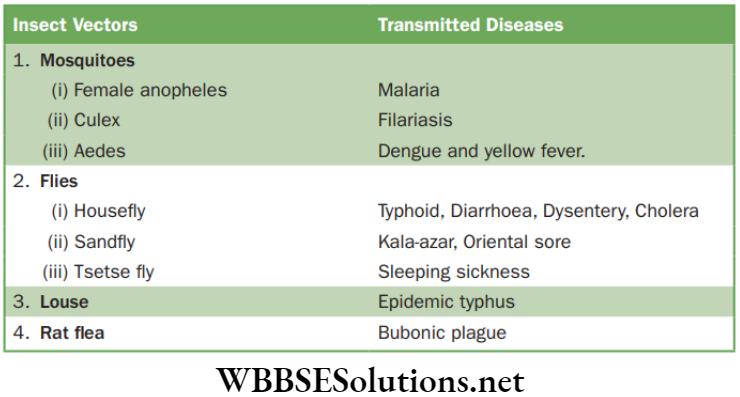
Chapter 4 Why Do We Fall Ill Symptoms of Disease: Organ Specific And Tissue Specific Manifestations
The microbes can enter into the body through various routes. The large size of human body offers all the possible places, organs or tissues, where they can reside and multiply. Different species of microbes can reside in different parts of the body. The most important thing that determines the destination of microbe is the point of entry.
- If they enter from air through the nose, they are likely to go to the lungs as in the case of mycobacterium tuberculosis, which causes tuberculosis.
- If they enter through the mouth, they can stay in the gut lining as in the case of typhoid causing bacteria, Salmonella typhi.
- HIV virus enters into the body through sexual contact and spreads to lymph nodes all over the body. Plasmodium enters through mosquito bite, it reaches to the liver and finally to the red blood cells.
Thus, symptoms of a disease completely depends on the targeted tissue or organ. If the lungs are the target, then symptoms will be cough and breathlessness. If the liver is targeted, then there would be jaundice. If the brain is the target, then headache, vomiting and unconsciousness are the signs.
In addition to these tissue-specific effects of infectious diseases, there may be other common effects which depend on the activation of the immune system. As the pathogen enters into the body of the host our immune system becomes activated and various immune cells like neutrophils, macrophages reach to the site of infection. The aggregation of these immune cells at the site of injury is called inflammation. In response to the invasion, our immune cells lead to the production of antibodies to eliminate that pathogen.
In some cases, the tissue-specificity of the infection leads to very general seeming effects. For example, in case of HIV, the virus on entering the body reaches the immune system to damage its functioning. Therefore, the body can no longer fight with even minor infections. As a result, even a small cold may lead to pneumonia.
Similarly, a minor gut infection can lead to diarrhoea with resulting in the loss of body fluids. Ultimately, other opportunistic infections kill people suffering from HIV-AIDS. It is also important to note that the severity of disease manifestations depend on the number of microbes entering into the body.
If the number of microbes is very small, the disease manifestations may be minor, whereas if the number of microbes is huge then the disease can be severe enough to be life-threatening. The immune system is a prominent factor that determines the number of microbes surviving in the body.
Principle of Treatment
What are the various preventative measures adopted by your family when you fall sick? When does the treatment involve medicines? Basically, there are two ways to treat an infectious disease. One would be to reduce the effect of the disease and the other to kill the causative agent. For the first, we can provide the treatment which will reduce the symptoms. For example, we can take medicines that bring down fever, reduce pain and assist in the recovery.
The treatment may reduce the severity of infection; but it is not enough to kill the pathogen. Hence, the disease may not cure and persist in our body depending upon the nature of pathogen. So, we need to remove the microbes from our body by neutralizing them. How do we kill microbes? One way is to use medicines that interfere with the synthesis of cell wall or various biochemical metabolic pathways to neutralize the pathogen as we discussed earlier.
For example, our cells make new substances by a mechanism which differs from that used by bacteria. We have to find a drug that blocks the synthesis of bacterial biochemical pathway without affecting our own. This can be achieved by the application of antibiotics. Similarly, there are drugs that kill protozoa such as the malarial parasite.
The reason why making anti-viral drugs are more difficult to is that viruses have few biochemical pathways of their own. They enter our cells and replicate its genome with the host’s genome and use our machinery for their life processes and survival.
Principle of Prevention of Disease
There are some limitations to treat an infectious disease and they are discussed below:
- Firstly, when someone is suffering from a disease his body becomes weak and takes time to recover completely.
- Secondly, the treatment takes time which means that someone suffering from a disease will definitely be confined to bed till convalescence.
- Thirdly, the individual suffering from an infectious disease may acts as a potent source to spread infection to other people or to the community.
Due to these limitations, it is popularly suggested that ‘Prevention of diseases is better than cure’.
There are various ways by which we can prevent the occurrence of disease and the following are as follows.
- For airborne infection, we can prevent exposure by providing living conditions that are not overcrowded.
- For waterborne infection, we can prevent exposure by procuring clean drinking water.
- For prevention from vector borne infections, clean environment is necessary.
- For example: Mosquito breeding can be stopped by ensuring cleanliness of water.
- Public hygiene and proper sanitation is the panacea to prevent infection
Chapter 4 Why Do We Fall Ill Vaccination
Vaccination is the administration of antigenic material to stimulate an individual’s immune system to generate adaptive immune response against the pathogen.
Nowadays, there is no reported case of smallpox anywhere across the globe, but consider a situation (hundred years ago) when smallpox epidemics was there. In such an epidemic, people feared of coming in contact with the sufferers to avoid the invasion of infection.
If a person encounters small pox once in his lifetime, the individual develops immunity against the disease for lifetime. This happens because when the immune system first recognizes an infectious particle, it responds against it and then remembers its specificity and develops the immunological memory for subsequent infections against the same pathogen.
So, when the same pathogen enters into the body of the host, now, this time the immune response is potent and intense to neutralize the antigen from the body. It is the basic principle of vaccination or immunization.
Chapter 4 Why Do We Fall Ill Various Diseases Caused By Pathogenic Agents
Diseases Caused by Viruses
Influenza
It is also known as Flu which is spread by influenza virus. In general, there are three strains of viruses A, B and C. Strains A and B are referred to as the common strains as they infect individuals throughout the world. Virus enters through our respiratory tract and affects the epithelial lining of mucous membrane of nose and throat. It spreads from person to person and also through airborne infection by coughing and sneezing as discussed earlier.
- Symptoms: The symptoms include sudden discharge from the nose, fever, headache, throat pain and later on as the infection progresses, body ache, muscular pain and inflammation takes place.
- Prevention: We should stay away from infected people. Use mask or handkerchief.
- Control: There is no effective measure against influenza. However, vaccines or antiviral drugs like Amantadine and Rimantadine are used.
Rabies (Hydrophobia)
Rabies spreads through the bite of mammals, like dogs, monkeys, cats, rabbits, etc. Rabies is a deadly disease and it is caused by the virus present in the saliva of infected animals. It enters into the blood and reaches to the brain and from brain, it is transmitted to different parts of the body.
- Symptoms: Severe headache, muscular pain, high fever, difficulty in swallowing, nausea followed by excessive salivation, difficulty in taking liquid foods and finally, fears of water develop. Hence, it is called hydrophobia.
- Prevention
-
- Wash the wound immediately with water or with any antiseptic.
- Mandatory immunization of stray dogs or other animals and also of pet dogs.
- Control: Rabies can be treated with Pasteur’s treatment discovered by Louis Pasteurin which 14 vaccines were given. Nowadays, only 5 anti-rabies vaccines are given at an interval of 0–3–7–14–30 days of dog bite.
Hepatitis or Jaundice
It is a liver disease and any kind of inflammation in liver due to jaundice leads to the impairment of digestion. The types of hepatitis are Hepatitis A, Hepatitis B, Hepatitis C, Hepatitis D and Hepatitis E. It usually spreads through contaminated food or water contaminated with hepatitis virus.
Hepatitis A: Hepatitis is an acute infectious disease of liver that affects both children and adult.
- Symptoms: High body temperature, headache, fatigue, joint paints, vomiting, nausea, loss of appetite, dark yellow skin and urine due to the presence of pigment named bilirubin and light coloured stool within 3–10 days of infection.
- Prevention
-
- Use of chlorinated, boiled or mineral water.
- Hands should be washed after cleaning the bed and vessels of the patients.
- Proper vaccination.
- Control
- Application of interferon injection as administered by the doctor.
- Patient should be fed with high calorie liquid diet like juices, radish, etc.
- Protein and fat rich diet should be avoided.
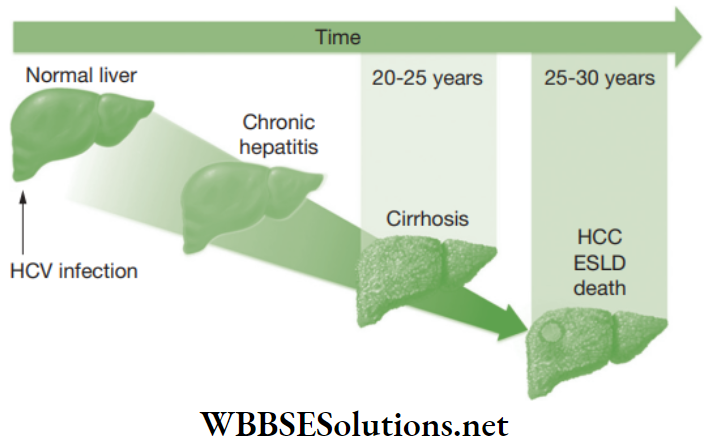
Hepatitis B: Hepatitis B is commonly known as ‘serum or transfusion’ hepatitis. This is the most fatal and common type of viral hepatitis among communities. The infection spreads through the infected blood from mothers to their babies or by sexual routes.
- Symptoms: Acute liver disease turned to chronic one, hepatic carcinoma, liver cirrhosis, etc.
- Prevention
-
- Alcoholics or liquor should be avoided.
- Intercourse with more than one partner (promiscuous) should be avoided.
Poliomyelitis
Polio is caused by Polio virus. The virus enters into our body through food and water and reaches the intestine. From bloodstream, it reaches to the CNS (Brain and spinal cord) where it destroys the motor nerves leading to paralysis of body parts, mainly legs.
Children between the age group of 6 months to 5 years are more prone to infection. It is transmitted among children by fecal-oral route through food or water contaminated with stools of patients.
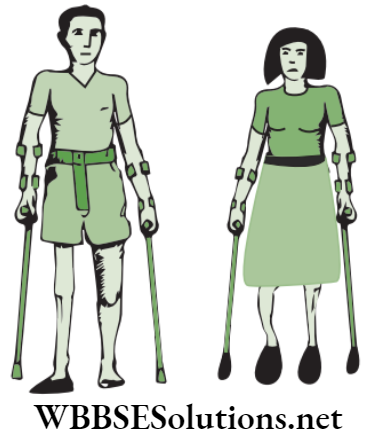
- Symptoms: The symptoms include sore throat and headache. As the infection progresses, fever, muscular pain, vomiting, stiffness of the neck and legs enhances and ultimately, paralysis of legs occurs.
- Prevention
-
- Physiotherapy helps in the early phase of viral attack to reduce the paralytic effect.
- Proper disposal of wastes.
- Proper hygiene and sanitation should be maintained.
AIDS
The term AIDS implies acquired immune deficiency syndrome. It is a fatal disease caused by human immunodeficiency virus (HIV), a retrovirus or RNA virus. When HIV virus enters the body, it attacks the major immune cells of our body like T-helper cells and macrophages. Later, the person becomes immune-deficient, who is prone to other opportunistic infections (secondary infections). The person dies of secondary infections.
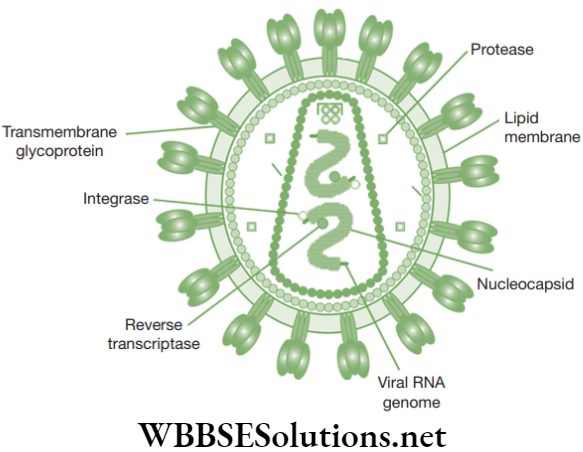
- Transmission: Transmission of HIV virus takes place through the following ways.
-
- HIV virus spreads through unprotected intercourse.
- AIDS spreads through contaminated blood having HIV virus during blood transfusion.
- During vertical transmission, the mother infected with AIDS may transmit the virus to her offspring during pregnancy.
- It can also be spread through the use of contaminated injections, needles, syringes, etc.
- Symptoms: Symptoms include regular fever, weight loss, shivering, swelling of lymph nodes, sweating at night, and in the later stage of the disease, amnesia and aphasia are observed.
- Prevention and control
- There is no effective medicine or vaccine that has been developed for its prevention.
- People should be made aware of AIDS by starting a general awareness programme.
- Syringes or needles once used should not be used again.
- Sexual contact with the HIV infected person should be avoided or condoms should be used.
- Contaminated blood should never be transfused and before transfusion , blood screening for HIV infection should be mandatory.
- Common razors and blades should not be used.
Some communicable diseases
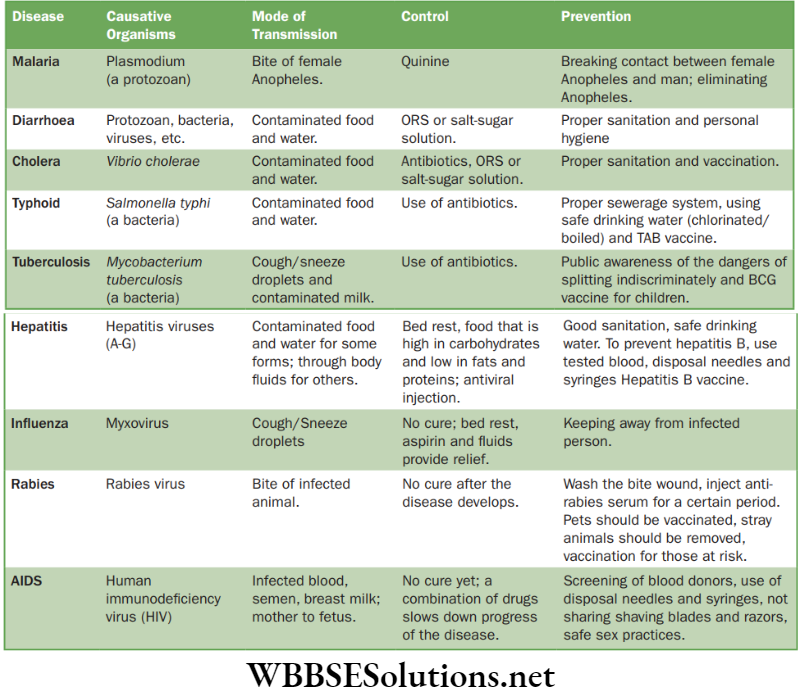
Chapter 4 Why Do We Fall Ill Diseases Caused By Bacteria
Tuberculosis
Tuberculosis, a communicable disease was first discovered by the German scientist, Robert Koch in the year 1882. He was awarded Nobel Prize for the discovery in 1905. It is caused by Mycobacterium tuberculosis. Mycobacterium enters through respiratory tract and reaches through various parts of the body, such as lungs, intestine and lymph glands.
After entering the body, the bacteria releases a toxin called tuberculin. The chances of infection are increased when a person inhales the infected droplets through coughing, sneezing, spitting of the infected person.
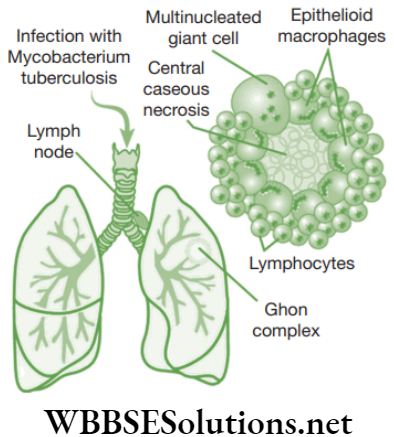
- Symptoms: The incubation period of tuberculosis includes from few weeks to a few years. The patient infected with tuberculosis feels sick and weak with a gradual loss of appetite and weight. The symptoms of tuberculosis depends upon the pathogen entering into the body and the organ it is infecting.
- Prevention
-
- Proper hygiene and sanitation.
- Infected person should be isolated and proper rehabilitation is necessary.
- Immunization with Bacillus-Calmette-Guerin (BCG) prevents tuberculosis.
- Control: Tuberculosis can be cured by various drugs but the major ones are Rifampicin, Streptomycin, Thioacetozone, etc.
Cholera
It is an acute infectious disease caused by Vibrio cholerae and it is transmitted through flies, contaminated water and food. The bacterium enters through the digestive tract and it reaches the intestinal epithelial cells and multiplies there.
It releases AB toxin which causes irritation in the epithelial lining of the cells leading to the secretion of large amount of water and salts out of the body. The incubation time of bacteria is few hours to days.
- Symptoms: Major diagnostic symptoms include watery stool, vomiting, dehydration with heavy loss of water and body fluids with electrolytes, loss of body weight, weakness, shrinking of eyes, etc.
- Prevention
-
- Person should be immunized with cholera vaccine.
- Boiled water and cooked food should be taken by patient.
- Proper hygiene and sanitation.
- Control
- To prevent dehydration, oral rehydration solution (ORS) should be taken immediately and intermittently.
- ORS includes electrolytes like sodium, potassium, chloride, etc. A drug named tetracycline is proved to be effective against the bacterium.

Typhoid
It is caused by Salmonella typhi found in the intestine of humans. It is the widest and most common communicable disease among communities. Salmonella is a rod-shaped motile bacterium, it enters through the oral route by contaminated food or water with faecal matter of typhoid patients. The onset of the infection begins through faecal matter. The symptoms appear within 10–14 days after infection.
- Symptoms
-
- Symptoms of the typhoid fever include continuous fever, headache with delirium (disorder of the mind), slow pulse, distended abdomen, watery stool and appearance of rashes on the body.
- Headache and fever reaches to its peak in the afternoon. The temperature rises each day in the first week and declines during the third or fourth day.
- Prevention
- Proper hygiene and sanitation.
- Disposal of faecal matter should not be avoided.
- TAB vaccination should be given as it provides immunity up to 3 years.
- Control: Chloromycetin, an important drug, is used to treat typhoid fever.
Diarrhoea
The main cause of diarrhoea is food poisoning. In case of food poisoning, the bacteria grows in food and releases toxin. When the food is ingested, toxins are released into the blood and absorbed by the gastrointestinal tract. In this case, the person frequently discharges semi-solid or watery stool.
The infection occurs through contaminated food, water, clothes and bed sheets, etc. There are various causative agents of diarrhoea like the bacteria E. coli, Salmonella, protozoan’s like Entamoeba histolytica, Giardia intestinalis and Balantidium, viruses like Rotavirus, Enterovirus, Adenoviruses and nematode or roundworm Ascaris.
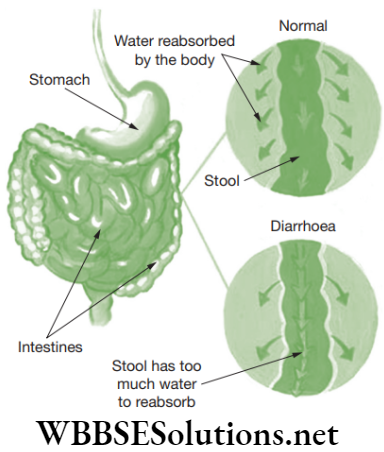
- Symptoms
-
- The major symptoms include dehydration, loss of appetite, nausea, vomiting, abdominal cramps, fever, hypotension, mucus and blood in the stool. It is one of the major causes of infant mortality in India.
- Due to dehydration, major loss of water, electrolytes and body fluids take place leading to the death of the person.
- Prevention
- Proper hygiene and sanitation.
- Before taking eatables, hands should be washed properly.
- Before taking any consumable, they should be washed properly.
- Control
- To prevent dehydration, oral rehydration solution (ORS) should be taken immediately and intermittently.
- Liquid stuff such as pulse soup, rice water, porridge (Khichdi), isabgol with water or curd should be given.
- Microbial drugs.
- Complete bed rest until patient recovers completely.
Anthrax
The causative agent of anthrax is a rod shaped non-motile bacteria, Bacillus anthracis. This disease is more common in wild and domestic animals, like sheep, horse, pig, cattle and including humans. The disease is transmitted by eating uncooked meat of infected animals.
- Symptoms: Symptoms include vomiting, nausea, and loss of appetite, pain and as the disease advances it leads to the death of person.
- Prevention: Vaccination is the only way to cure this disease.
- Control: Antibiotics should be taken to control it.
Peptic Ulcers
These are the inflammatory painful bleeding regions in the stomach and duodenum due to frequent consumption of fast or junk food. However, occurrence of peptic ulcer is also possible in certain lifestyle. Stressful life also increases the gastric acidic secretion and leads to the development of peptic ulcers.
Two Australians made a breakthrough that a bacterium called Helicobacter pylori was the causative agent for peptic ulcers. Robin Warren (born 1937), a pathologist from Perth, Australia, saw these small curved bacteria in the lower part of the stomach in many patients. He noticed the symptoms of inflammation around these bacteria.
Barry Marshall (born 1951), a young clinical fellow became interested in Warren’s findings and succeeded in isolating the bacteria from these sources. Marshall and Warren found that an antibiotic Amoxicillin is the cure for this disease and later on due to his findings both were awarded Nobel prize for 2005 in Physiology and Medicine.
- Prevention
-
- Fast or junk food should be avoided.
- Spicy and oiled food stuff should be avoided.
- Control
- If acidity persists for a long time, then immediately consult the doctor.
- Amoxicillin drug is advised.
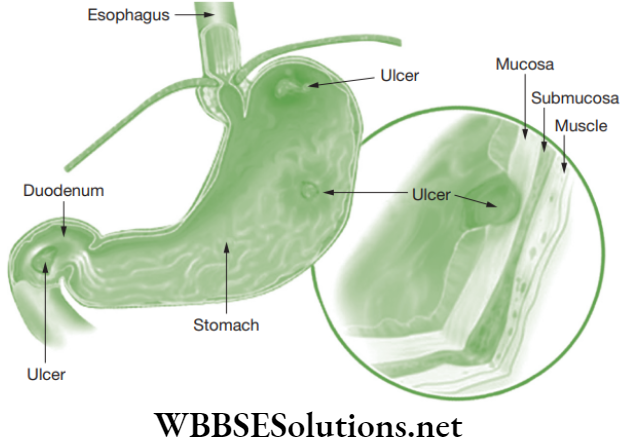
Chapter 4 Why Do We Fall Ill Diseases Caused By Protozoa
Malaria
According to reports, more than two millions of people die every year due to malaria. It is caused by Plasmodium and it spreads through the bite of vector, female Anopheles mosquito.
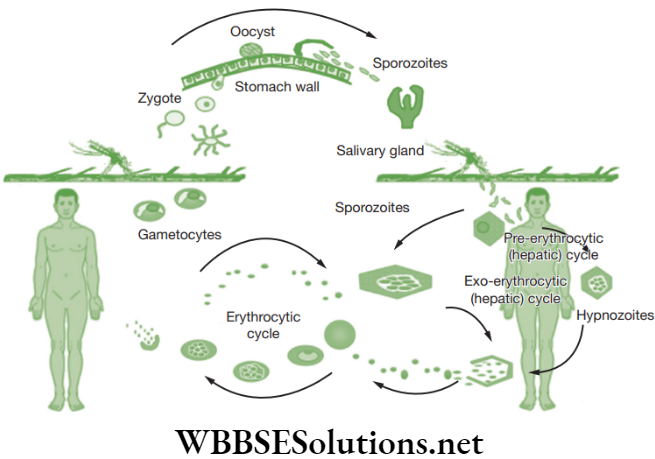
- Symptoms: Symptoms include extreme cold, shivering, nausea, vomiting, headache, high fever, tachycardia, high respiration, muscular pain, and at the end extreme sweating occurs and body temperature comes to normal. In few cases, enlargement of spleen and liver is reported.
- Prevention
-
- Mosquito nets should be used while sleeping.
- Wire gauze should be used on windows and doors to prevent the entry of mosquitoes.
- Insect repellents should be used.
- Control
- Quinine, a drug extracted from the bark of the cinchona tree is used to deal with malarial parasite.
- Mosquito larvae should be destroyed by adding fumigants or kerosene oil.
- Biological control is an effective measure to control the population of larvae. The introduction of Gambusia fish in the water body naturally kills the larvae.
- By undergoing chemical control with the application of insecticides like DDT, Malathion and Parathione, malaria can be effectively prevented.
- The breeding grounds, pits, ditches around human dwellings should be drained and the collection of water in cooler, water tanks, tyres, etc., should be avoided.
Chapter 4 Why Do We Fall Ill Classroom Corner Fill In The Blanks
Question 1. The pathogens of disease are ______.
Answer. Protozoa
Question 2. ______ are the organisms which carry specific germs.
Answer. Vectors
Question 3. Plague is transmitted by ______.
Answer. Rat Fleas
Question 4. ______ is the diseases for which the first vaccine was developed from living organisms.
Answer. Small Pox
Question 5. ______ are the inactive toxic substances extracted from bacteria.
Answer. Toxoids
Question 6. Small pox vaccine contains ______ virus.
Answer. Cowpox
Question 7. ______ is the pathogen which is responsible for ascariasis.
Answer. Ascaris Lumbricoides
Question 8. Anopheles spreads by ______.
Answer. Malaria
Question 9. ______ is the vaccine used to cure the disease caused by Salmonella typhi.
Answer. Typhoid
Question 10. Trachoma is an infection in the ______.
Answer. Eye
Question 11. ______ is a fatal disease that reduces the immunity of the body.
Answer. Aids
Question 12. Disease which is transmitted through placenta is ______.
Answer. German Measles
Question 13. The immunity developed in our body due to the vaccination of polio and measles is an example of ______.
Answer. Artificial Active Immunity
Question 14. ______ diseases occur occasionally or irregularly.
Answer. Acute
Question 15. Pathogens contain unique type of protein called ______ which causes diseases in our body.
Answer. Antigen
Chapter 4 Why Do We Fall Ill Match The Columns
Question 1.
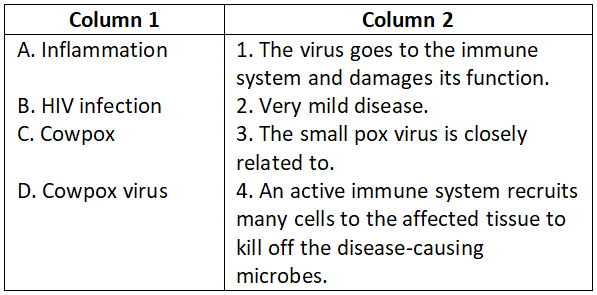
Select the correct option.
- A-1, B-2, C-3, D-4
- A-4, B-2, C-1, D-3
- A-4, B-1, C-2, D-3
- A-1, B-3, C-2, D-4
Answer. 3. A-4, B-1, C-2, D-3
Question 2.
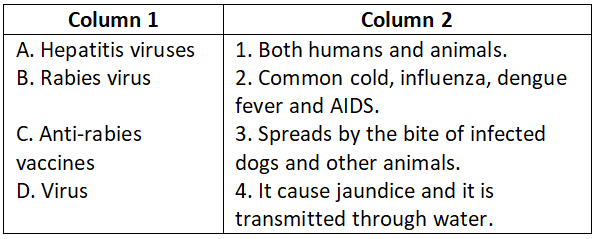
Select the correct option.
- A-1, B-2, C-3, D-4
- A-4, B-3, C-1, D-2
- A-4, B-1, C-2, D-3
- A-1, B-3, C-2, D-4
Answer. 2. A-4, B-3, C-1, D-2
Question 3.

Select the correct option.
- A-1, B-2, C-3, D-4
- A-4, B-3, C-1, D-2
- A-4, B-1, C-2, D-3
- A-3, B-4, C-2, D-1
Answer. 4. A-3, B-4, C-2, D-1
Question 4.
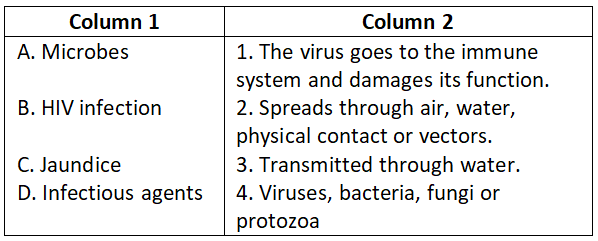
Select the correct option:
- A-4, B-1, C-3, D-2
- A-4, B-3, C-1, D-2
- A-4, B-1, C-2, D-3
- A-3, B-4, C-2, D-1
Answer. 1. A-4, B-1, C-3, D-2
Question 5.

Select the correct option:
- A-4, B-1, C-3, D-2
- A-4, B-3, C-1, D-2
- A-4, B-1, C-2, D-3
- A-3, B-4, C-2, D-1
Answer. 4. A-3, B-4, C-2, D-1
